Ueber allen Gipfeln Ist Ruh' D 768
Posted by Richard on UTC 2020-01-01 08:14
In the most generally accepted accounts, Johann Wolfgang Goethe (1749-1832) is said to have written down the first version of this poem on 6 September 1780.
The context
Our readers, bright as they are, can't be expected to carry the chronology of Goethe's life around in their heads, so let's put that date in some context for Schubert fans. The second column contains Goethe's approximate age, the third column some event that is noteworthy from our perspective.
| 1770-71 | 21 | Strasbourg and Friederike Brion. |
| 1774-75 | 25 | Goethe skating in Frankfurt. |
| 1775 | 26 | First trip to the Gotthard region. |
| 1775 | 26 | In service with Duke Carl August of Sachsen-Weimar-Eisenach (the Duke was 18). |
| 1775 | 26 | First draft of Faust (the Urfaust). |
| 1778 | 29 | Der Fischer. |
| 1779 | 30 | Second trip to the Gotthard region. |
| 1780 | 31 | Wrote Wandrers Nachtlied II. |
| 1786-90 | 37-41 | Complete Works (8 vols., Göschen, Leipzig) |
| 1789 | 40 | Heidenröslein published. |
| 1790 | 41 | Faust. Ein Fragment (with Gretchen am Spinnrade). |
| 1795 | 46 | Nähe des Geliebten. |
| 1797 | 48 | Third trip to the Gotthard region. |
| 1815-19 | 66-70 | Wandrers Nachtlied II in Complete Works (20 vols., Cotta, Stuttgart). |
The table encompasses the ten years before 1780 and the thirty-five years that follow until the publication of the Complete Works by Cotta. There is much of importance in Goethe's busy life that is missing from the table, but that doesn't matter for our present purpose.
The poem
Here is the text of the poem we entitle for our convenience Wandrers Nachtlied II. When it was finally printed (in the Cotta Complete Works) it was positioned following an earlier poem called Wandrers Nachtlied and was simply titled Ein gleiches, 'Another one'. What follows is the text of that edition:
| Ueber allen Gipfeln Ist Ruh', In allen Wipfeln Spürest Du Kaum einen Hauch; Die Vögelein schweigen im Walde. Warte nur! Balde Ruhest du auch. |
Over all the mountain-tops there is peace, in all the treetops you sense scarcely a breath of air; the little birds go silent in the forest. Just wait! Soon you will be at peace, too. |
A test for the quality of a poem is the feeling the reader gets that the poem unfolds its meaning a little more with each reading – every time we read it we notice something new that our plodder's mind has so far missed. Good poets – even geniuses such as Goethe – may spend hours on a few lines, so the fact that a thirty-second speed-read leaves a lot unseen should not surprise us.
Eight lines, 24 words – how much can one write about that?
An extraordinary amount, in fact.
In the following discussion of the poem we are going to take this small thing and unfold it. We are not going to do this with the grinding thoroughness of Teutonic literary 'interpretation', a process that systematically takes the clock apart to leave only tiny screws and cogs scattered over the workbench, the ticks and chimes now a distant memory.
The purpose of our inspection is not to dismantle the clock but to open its operation up to non-specialists, particularly those who have little or no German – and particularly, of course, Schubert fans, who approach the song lyrics from a musical rather than a text critical direction.
The poem is only translatable in the most primitive respect. In German, the poem – so brief, so apparently simple – in the course of profound reflection unfolds its complexities and ambiguities to an extent that leaves the native speaker astonished. What hope then is there for the translator? The only hope is not to mislead the reader and to make at least the superficial reading as accurate as possible.
Analysis
In other accounts of this poem the discussion traditionally begins with its colourful backstory. We are not going to do that here. We shall begin with an analysis of the poem itself, unclouded as far as possible by biographical speculations. We shall then conclude with some notes on its backstory, which is still a matter of discussion among Germanists even today. For our readers – masochists the lot of 'em – such journeys to Compostela on their knees are routine stuff.
Metrics
The poem is a masterpiece of metrical skill. But, true to the idea of 'quality' we mentioned above, just how skilled it is only becomes apparent on closer inspection.
There are several ways of scanning this hypnotic subtlety, here is just one (if you know a better one, go to it):
Ueber | allen | Gipfeln
Ist Ruh',
In | allen | Wipfeln
Spürest Du
Kaum einen Hauch;
Die|Vögelein|schweigen|im Walde.
Warte nur! | Balde
Ruhest du auch.
Key: long/stressed syllable, ¯, short/unstressed syllable, ˘. The divisions between the feet are marked with '|'. Swots can hover the cursor over the syllables to see the prosody terms and markup for each foot.
The reader who is not too keen on this kind of metrical display should just listen to the musical setting done by that other metrical master Schubert. Everything will become clear.
Form
What our colourful pedantry does show, however, is just how flexible Goethe's use of metre is: this poem cannot be fitted into any existing poetic form – sonnet etc. – because it creates its own organic form that responds only to its own exigencies of expression. The metrical structure of each line may occur in some German poem or other, but the combination of them in these eight lines is unique in German poetry.
Despite the metrical irregularity within the poem, it never degrades into mere free verse. Goethe is writing poetry with metrical structure and with rhyme, but not to a stanza formula.
Third-rate poets open their eyes at daybreak (or lunchtime, more likely) and say to themselves, 'Today I'll write a Petrarchan sonnet', then spend the rest of the day trying to batter language into submission in order to achieve that form. Dylan Thomas comes to mind in this connection.
Goethe could be a formalist, too (the Römische Elegien , for example), but even then his genius was such that he never, ever, gives the impression that his text has just emerged from a good doing-over in a poetic pestle and mortar. We used to say of such studied mangling at one time that it 'smelled of the lamp'.
Rhyme
In conventional notation the end rhymes are a-b-a-b-c-d-d-c. There is a close internal rhyme between spürest and ruhest:
Ueber allen Gipfeln
Ist Ruh',
In allen Wipfeln
Spürest Du
Kaum einen Hauch;
Die Vögelein schweigen im Walde.
Warte nur! Balde
Ruhest du auch.
Eight short lines, 24 words in total – an absolute nightmare for end-rhymes that would wreck most poets – Ludwig Rellstab for example. Every two or three words a meaningful rhyme word – 'thunderbolts and lightning | very very frightening'! How can anyone keep that up?
Goethe could.
Does the reader read Goethe's poem with unease, smelling the lamp? Of course not! Does any word stand out as being just there to make the rhyme? No. It is one indispensable mark of great poetry that we think it effortless – we simply do not notice the constructive act. Here every rhyme, every word and every meaning is in its place, the place where we expect it.
Enjambement, caesura, punctuation and rhythm
As if all that were not enough, the poem is a masterclass in the control of poetic flow.
Let us rewrite the lines to reflect the use of enjambement and caesura. (The author is aware that he has gone beyond the strict definition of the term 'caesura' here, but finds it the least-worst term in this context.)
Ueber allen Gipfeln ist Ruh',
in allen Wipfeln spürest Du kaum einen Hauch;
die Vögelein schweigen im Walde.
Warte nur!
Balde ruhest du auch.
Even the graduated punctuation reflects perfectly the syntax behind the flow of ideas: the first three periods articulated with comma, semicolon and full stop as the objective phenomena of the silent world; the final two the transfer of that silence to the individual.
1a— Ueber allen Gipfeln ist Ruh' ,
1b— in allen Wipfeln spürest Du kaum einen Hauch ;
1c— die Vögelein schweigen im Walde .
2a— Warte nur! !
2b— Balde ruhest du auch .
The stops are all caesurae, but they are by no means of equal length or importance. Their duration builds up through the poem: short [,], medium [ ; ] and long [ . ] [ ! ]. Schubert, sensing this without the need for diagrams, gives the important pause after Warte nur! its true value by repeating the phrase, done also without any sense of contrivance – another genius at work.
The full stop after Walde is by far the most important punctuation mark in the poem. For the moment we merely mention this fact, but it is the hinge around which the entire poem turns.
If Schubert delivers us a masterclass in understanding Goethe's metrical organization, Dietrich Fischer-Dieskau, in his recordings of this piece known to your author, delivers a masterclass in singing the enjambements and caesurae in Schubert's setting.
As it was with the rhymes in the poem, so it is with its rhythm: we simply do not notice it, so close it is to the rhythm of everyday speech. There is nothing contrived or mannered in the way the words flow, not a whiff of the lamp. Metric, enjambement, caesura, rhythm all combine in complete harmony.
The rhythm accelerates and decelerates as we would expect it to. It is yet another remarkable testimony to the brilliance of Schubert's setting, that he takes Goethes speakable verse and makes it singable, whilst still preserving its identity with the rhythms of everyday speech. Even the extension of Balde, in order to avoid the submergence of this most important word, strikes the listener as completely without affectation, completely natural.
Grammar and syntax
The vocabulary, grammar and syntax of the poem are also completely transparent – no native speaker needs to reach for a dictionary or puzzle over grammatical or syntactical complexities or even read a line over again. This simplicity, this directness, is one of the characteristics that make it such a great poem. Readers who with furrowed brows have struggled with us through some other great German poems will only agree.
What is meant here by 'transparent'? The term is used here to mean that the grammar and syntax never get in the way or distort the meaning passing through them. In order to explain that, we need some grammatical analysis. It's an easy analysis which will present no problems even to beginners in German.
Within the poem, grammatically simple statements are laid down one after the other in simple parataxis, without any conjunctions. The statements making up the first six lines are simple empirical observations without the slightest rhetorical trickery (no metaphors, for example). There are no abstractions and no descriptive adjectives decorate the simple nouns.
Ueber allen Gipfeln ist Ruh',
In allen Wipfeln spürest Du kaum einen Hauch;
Die Vögelein schweigen im Walde.
Warte nur!
Balde ruhest du auch.
Five simple statements, five verbs.
We may choose to understand the poem in a symbolic way, but its surface is entirely objective, observable, real-world. This surface of observed phenomena enables the poem to be taken at face value and thus understood by any reader.
As a demonstration of just how astonishingly plain Goethe's language in this poem is, we might compare it to another masterpiece written in English about thirty years before the present poem: Thomas Gray's Elegy Written in a Country Churchyard (c. 1750), the famous first four lines of which give us also a paratactic list of seemingly empirical observations:
The curfew tolls the knell of parting day,
The lowing herd wind slowly o'er the lea,
The ploughman homeward plods his weary way,
And leaves the world to darkness and to me.
Only 'seemingly' empirical, though, because adjectives and adverbs are there to reflect the twilight mood ('parting', 'slowly', 'weary') and the vocabulary is freighted with similar depressants: 'tolls the knell', 'winds', 'plods', 'leaves the world to darkness'. The poet is shaping experience for effect.
In contrast, Goethe's poem is pared back to the absolute essentials. Phenomena are reported, not commented. There is no shaping of observation.
It also displays that other characteristic of great poetry: no word can be removed, no word can be added without damaging the whole.
Ueber allen Gipfeln ist Ruh',
in allen Wipfeln spürest Du kaum einen Hauch;
die Vögelein schweigen im Walde.
Language
To all his other accomplishments – scansion, rhyme and syntax – we can add Goethe's infallible sense of the mot juste. Sensitive translators are driven to despair trying to reflect that perfection in a different language.
The vocabulary of Goethe's poem may not be as obviously charged with mood as that of Gray's, but it is loaded with meaning at a deeper level.
We might begin our examination by looking at ist, 'is', in the first line. The word is not here in its most frequent use as a simple copula ('the bus is red') but as a statement of the 'existence' of peace over the mountain-tops: Ueber allen Gipfeln ist Ruh', 'Over all the mountain-tops there is peace'.
A German native speaker might expect a careless modern cliché, now weakened with overuse, such as herrscht, 'rules' or 'reigns' in its place. Goethe sticks with the precision of the almost Scholastic (esse, essentia) formulation, ist.
Next we encounter another translator's nightmare, spürest Du. The verb spüren means 'to feel', 'to sense', 'to perceive' or 'to be(come) aware of' something. It still carries traces of its etymology in Old High German of following a track or a scent (eine Spur), in that it implies active perception, not simply passive reception. It is probably therefore closer to 'detect' than to 'sense', but what translator would ever write that?
Here the narrator is looking attentively at the treetops, trying to detect any movement that would indicate a breeze. We note the empirical precision: weak poets would write 'there was a light breeze', but one cannot see a breeze, light or strong, only detect its presence by the motion of the treetops. It is on these twigs at the top of the trees that the narrator's attention is focused – once again we note that active procedure, spüren, 'detect'.
Observing the treetops rather than the lower foliage sheltered in the wood is another example of the sound empirical basis on which Goethe's poem rests. This empirical basis comprehends the senses of sight and hearing, that is, only those 'reports on experience' – which are all that he gives us.
Goethe's use of Du, 'you', is worthy of special note. German has a widely used technique for generalising experience, the pronoun man, the equivalent of the now almost defunct 'one' in English. A modern writer in German would probably write spürt man kaum einen Hauch, 'one senses scarcely a breath of air'.
But Goethe chooses to write Du, 'you', which is much closer to spoken German and much more concrete – almost the English 'you' in the sense of 'your and/or I'. With Du he speaks to the reader and to himself. 'Go in fear of abstractions' wrote the American Modernist poet Ezra Pound, which is exactly what Goethe was doing nearly two centuries before that was written.
In the second line of this poem he uses Ruh[e], for which the dictionary delivers in excess of twenty rough equivalents in English. Well, that's easy enough then – take your pick. However, in the last line we find that the reader will soon be ruhen, 'resting', which many readers take to be a metaphor for resting in the grave.
The metaphorical brace between the noun 'peace' of the scene in line 2 and the verb 'peace' in line 8 is quite apparent and must be respected. Worse: Goethe – genius – seems to have packed into that brace the potential span between the gentle, settling down of a woodland evening and the even more silent peace of the grave.
Goethe's use of Hauch, 'faint breath' also gives us pause for reflection. In German, Hauch can refer to the faintest of breezes. Schubert fans will remember Rückert's masterly Dass sie hier gewesen (D 775) the scent of the beloved which the east wind hauchet, 'wafts weakly' in the air.
But Hauch is also frequently associated with 'breath' and particularly the faint last breath at the end of life, often associated with the departure of the soul, the Greek πνεῦμα. In which case spürest Du kaum einen Hauch, 'you can scarcely detect a breath' would bring to the pre-modern mind the memory of death, an all too familiar memory before it became something that happened inside a facemask at the end of a tube.
If we set our language sensitivity receptors to MAX we may notice the subtlety of kaum einen Hauch, 'scarcely a breath'. Some copyists have occasionally mangled this to keinen Hauch, 'not a breath', which not only wrecks the metre but replaces the living, experiential 'scarcely a breath' with the dead, abstract 'not a breath'.
Goethe tells us that Die Vögelein schweigen im Walde, 'the birds go silent in the wood'. In this context schweigen, 'to be silent', 'to say nothing' is used with precise intentionality. The birds in the forest are not simply 'silent', as in 'quiet' or 'still', they actively 'become silent' or 'choose to be silent' or 'go silent' or even 'hold their tongues'.
When we understand the use of schweigen to designate a process of becoming silent, we can appreciate something else that is not immediately clear to modern readers. For Goethe, Nacht did not simply mean 'night' as we now understand it, but as something closer to 'evening', 'nightfall' or 'twilight'. It was the same for Mozart: we do not expect his Eine kleine Nachtmusik (1787) to be churned out at midnight. It is a piece for the evening – a 'serenade'.
But most importantly, the observations which Goethe recorded in this poem cannot have been made at night. He wouldn't have been able to see the mountain tops or the almost motionless treetops. The birds would have stopped singing long before. The time of the poem is exactly that of Gray's Elegy, late evening.
Yes, but what does it mean?
In a 1982 survey in West Germany (remember that place?) this poem was voted the most popular of Goethe's poems. There are those who claim that it is the most popular classical poem in German altogether. A poem doesn't achieve this level of popularity by being obscure and Wandrers Nachtlied II is no exception. It has a surface which many readers clearly find emotionally very satisfying.
At the same time the poem also has great profundities of language and structure. Thoughtful readers are repaid in full for their efforts. We shall now look at some of those profundities. It is remarkable what Goethe packs into eight lines and twenty-four words, as we have already noted.
Even so we must also avoid over interpreting the text. As we shall see later, Goethe himself – at least for thirty years or more – did not seem to be particularly aware of the outstanding quality of his own poem or its potential for symbolic understanding.
This is not the place to ring the bell on yet another round in the debate on meaning in poetry. Is the meaning of a poem defined by whatever happens to have been in the head of its creator at the time of writing? Or is the meaning of a poem whatever happens to pop into the reader's head when reading it? If the former, then how on earth can we be expected to know what that was? If the latter, did the poet really have no influence on meaning? 'Shall two know the same in their knowing' (©Ezra Pound, C93:631).
Axes of meaning
The 'meaning' of the poem seems to lie along a number of 'axes' in the text. These are not simple themes or metaphors, but thematic progressions that appear to underlie the poem. We might risk pretentiousness and speak of 'multidimensional' meaning.
The first and simplest axis is one of descent. In the first line we are focussed OVER the mountain-tops, in the third line ON the treetops; by the sixth line our attention is directed to the birds IN the woods (within which we are standing) and in the last line we are on the surface, along with the narrator-reader. In other words, the view of the poem sweeps downwards from heaven to earth.
Translators, no doubt influenced by the real-world location of the composition of the poem among the rolling hills of the Thuringian forest, often render Gipfeln as 'hill-tops'. We take the position that Goethe wrote mountain-tops and meant-mountain-tops.
In contrast, some commentators on the poem have found an axis of ascent. Goethe, we are told, wrote the poem on the summit of the Kickelhahn (861 m, 2,800 feet), near Ilmenau in the Thuringian Forest. It was the highest point for some way around and certainly the highest point in his Duke's territory.
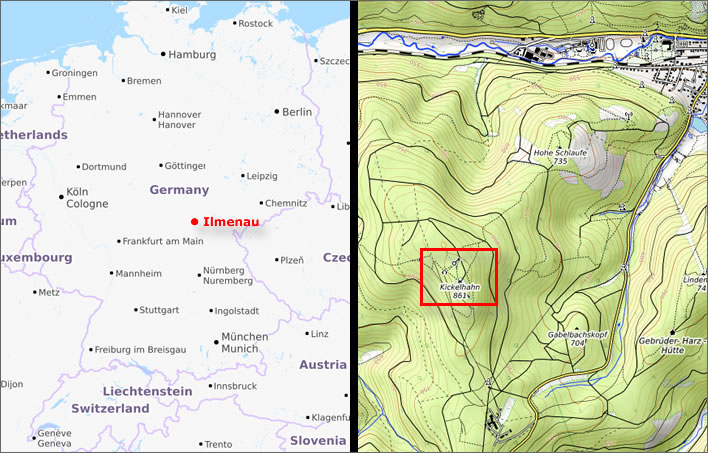
Germany, Ilmenau and the Kickelhahn (with Ilmenau to the north-east). Base image: Open Street Map.
Immediately before the composition of this poem Goethe and his manservant had climbed up one of the routes leading to the summit, an ascent of around 300 m above the town that takes a good hour on foot. Nowadays the Kickelhahn is completely forested. In Goethe's time the summit seems to have been relatively clear. Close to the summit there was a rudimentary hunting lodge with a primitive shelter and accommodation.
In this sense, therefore, Goethe's viewpoint is looking down on the countryside around him – a situation which makes the talk of the treetops much more plausible and which would create an axis of ascent to his present, commanding position.
Simultaneously with the change in elevation (whether up or down) we experience an axis of distance. Our view is brought from the distant mountain-tops, to the treetops, to the woods (within which we are standing) and then to the narrator-reader, in the inmost sense of the mind of the narrator-reader.
The fourth axis we traverse in this poem is more speculative. It is an axis of the nature of existence – more of a pyramid than an axis. The mountains are the world of rock and water, inorganic existence in other words, the foundations of all things. The layers above this all belong to the organic world. The first level of the organic world is the plant world, as represented by the trees, a level which depends on the inorganic base beneath it. The next organic level is the animal world, here represented by the birds, a world which in turn depends upon the plant world beneath it. Finally we arrive at the human-spiritual world of the narrator-reader, depending on the cumulative existence of the lower layers.
To those readers who think this last axis to be far-fetched, overloading this fragile eight-line poem with meanings that were simply not intended by Goethe, we ask only that they reflect on the fact that the year before this poem was written, Goethe had just completed his second journey to the Gotthard region of Switzerland. The first journey had taken place only four years before that.
Each of these journeys had taken him on long intellectual excursions concerning the nature of the geological and natural world. He arguably put more effort into his work in the natural sciences over the whole of his lifetime than he did in literature alone.
He had ascended and descended to, from and past regions of rock, snow and every form of natural life. Simultaneously with those journeys he was brooding on Faust and the elemental spirits of the natural and human world. He was a longstanding pantheist and polytheist (though he wisely kept this to himself). He had a synthetic cast of mind which always tried to understand natural phenomena in terms of some larger idea. It was a trait that made him a provocative thinker, but a useless scientist.
At the Gotthard Pass summit he saw himself in the centre of a 'crown' of jagged peaks which rested on the deepest roots of the earth and which here rose, leaning together, towards the heavens. The insight is nonsense, of course, but it helped to give us the broader truth of Faust.
Asserting this axis of existence does not require us to imagine a conscious effort on Goethe's part to construct this axis. It is much simpler: that is the way his mind worked. He had a 'morphological' understanding of world, which infused his geological studies, his later work on the Metamorphose der Pflanzen, 'Metamorphosis of Plants' and on his obsessive work on the Farbenlehre, 'Theory of Colours'.
It is a sweeping assertion on our part, but one might say that Goethe never just passively 'saw' things, he 'processed' and 'ordered' everything he encountered. As a child he collected and ordered the wax seals from the letters his father received; as a fifty-year-old he collected and purchased rocks and minerals and ordered them according to his geological understanding.
Some German analysts of the poem believe that this last axis is a misinterpretation which arises from our knowledge of Goethe's later preoccupation with the Natural Sciences. According to this viewpoint, at the time of writing this poem Goethe would have viewed the landscape stretched out before him in that twilight in much the same way as any other sensitive human being.
This may well be true, but Goethe from his earliest years was sensitive to the forms and meaning of landscape. It may not have been the preoccupation it eventually became, to the exclusion of his literary work, but its embryo was always there. As we suggest here, Goethe's travels in the Gotthard region in the preceding years activated his spiritual identification with the forms and structure of landscape. Those ideas were in his head and we cannot simply ignore them or wish them away.
In our look at the biographical context to the poem we shall also see that one of Goethe's principal preoccupations at the time he wrote this poem was with the geology of the region and its potential for exploitation. Geological concepts were not just in his head – his head was full of them.
The crux
These axes represent transitions through various states. How can a poem of eight lines and twenty-four words bear all this meaning? The answer to this can be seen in our consideration of the syntax of the poem.
1a— Ueber allen Gipfeln ist Ruh',
1b— in allen Wipfeln spürest Du kaum einen Hauch;
1c— die Vögelein schweigen im Walde.
2a— Warte nur!
2b— Balde ruhest Du auch.
The axes run parallel to a point where they meet at the full stop. This is the crux, the hinge, if you like, of the entire poem. At this point all the axes are bound together into the figure of the narrator-reader, the human at the centre of all things. Up until this moment, the narrator has been invisible.
The direct speech of Warte nur!, 'just wait', suddenly shocks us into the realisation that another person is there, the Du, 'you'. Is the reader the 'you', or is the narrator holding a monologue with himself?
The biographical context
A good reason for keeping a discussion of the biographical background of the poem to the end is that this background is a source of confusion and a battlefield for scholarly opining to this day. We purists like to treat poems as self-contained, encapsulated works that are best studied without allowing that complicated nuisance, the poet, to intervene.
Wandrers Nachtlied II is a particular victim of this fascination with biography, but even we literary ascetics have to admit that we can't just leave the biographical background of the poem untouched.
But down the years the members of the Goethekult have hoovered up various bits of nonsense to create the 'factual' biographical whole which confronts the enquirer today. The readers of this website know better than that – let's go through this nonsense, toss the pieces into the air and watch the wind of reason disperse the chaff.
Firstly, when was it written? Goethe visited the Kickelhahn for the last time on 27 August 1831, the day before his 82nd birthday. He died seven months later. On the occasion of that visit he is reported to have stated that he had written the poem almost 48 years before, on 7 September 1783. We know from the written records of his busy administrative life in that period that he cannot have been on the Kickelhahn on that date. If that visit did take place in 1783, then it was on some other date.
Poets and accurate dates, eh? As our readers know too well, those two things do not belong in the same sentence.
The other date suggested for the composition of the poem is 6 September 1780. We know that Goethe had paid an administrative visit to Ilmenau, the town at the foot of the Kickelhahn, on that occasion. We know from a letter written to his friend/mistress in Weimar, Charlotte von Stein, dated 6 September, that Goethe had had a series of meetings on that day that had not filled him with love for his fellow man.
At the end of the day he ascended the Kickelhahn – fled Ilmenau would not be an overstatement – and found himself at last surrounded by Nature at peace – 'pure heaven' he called it. He decided to stay at the 'hunting lodge' on the summit, a two story wooden hut, the upper storey of which was a primitive dormitory.
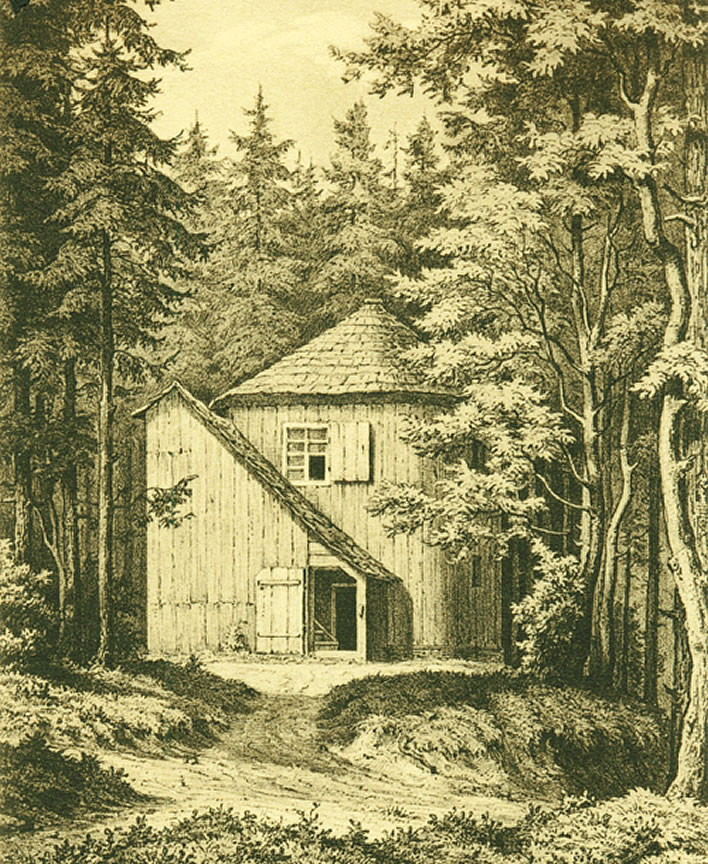
A drawing for a picture postcard of the 'hunting lodge' at the summit of the Kickelhahn, showing its state before the fire of 1870 which destroyed it completely. It became known as the Goethehäuschen, 'Goethe Hut'. Image: Goethezeitportal.
The rest of his description of the landscape for Charlotte is quite like a prose version of the poem. Peace at last!
If we take the situation Goethe described to Charlotte as the biographical core of the poem – and why shouldn't we? – there are considerable consequences for our interpretation. Goethe's mood as it is reflected in the poem was not a premonition of approaching death, as it is now usually read, it was simply the wish for a bit of peace and quiet in Nature, away from those troublesome humans.
The thirty-one year old Goethe was at the height of his powers and had no reason to brood on death. This is a poem written by a tired man observing the fall of evening as the natural world sinks into silence and peace and looking forward to his own peaceful sleep in the hunting lodge on the hill.
So far, so romantic – but we grumblers and pedants never sleep. For if we take that as the date on which he wrote Wandrers Nachtlied II, why is there no mention of it in any letter to Charlotte? He also wrote to her on the 7th and 8th of September and still made no mention of it.
6th Sept. 80.
I have made my bed on the Kickelhahn, the highest mountain in the region, which one could call in a more resonant tongue Alecktrüogallonax, in order to escape from the desert of the little town, from the complaints, the demands, the incorrigible complexity of humans. If only all my thoughts from today were written down there would be good things among them.
Alecktrüogallonax: The Kickelhahn gets its name from the Auerhuhn, the 'capercaillie' or 'wood grouse' (Tetrao urogallus) which populated its wooded flanks. Out of the Latin name Goethe has constructed a joking macaronic of Greek and Latin: ἀλεκτρυών (= cock) + gallus (= cock) + ἄναξ (=ruler). Goethe, his mind on the Hermannstein in the vicinity may also be alluding to Ritter ('Knight') Hermann von Witzleben (1340-1393), the ruler of this locality who gave his name to the stone. Who knows?
d. 6. Sept. 80. Auf dem Gickelhahn dem höchsten Berg des Reviers den man in einer klingernden Sprache Alecktrüogallonax nennen könnte hab ich mich gebettet, um dem Wuste des Städgens, den Klagen, den Verlangen, der Unverbesserlichen Verworrenheit der Menschen auszuweichen. Wenn nur meine Gedancken zusammt von heut aufgeschrieben wären es sind gute Sachen drunter.
[NB: Goethe's correspondence is online at zeno.org.]
What he meant by there being 'good things' among his thoughts despite the turmoil of the day… could that be his poem? Desperation whispers in our ear, 'possibly'; Reason, 'probably not'.
Dearest one, I climbed into the cave of the Hermannstein, in the place where you were with me [that time] and kissed the 'S' that looked as freshly drawn as if done yesterday and kissed again so that the porphyry breathed out its entire odour of earth in order to answer me in its own way. I bid the hundred-headed god, who brought me so much and changed me so much and who has nevertheless preserved your love for me and this rock to continue so and make me worthy of his love and of yours.
Hermannstein: the 'Hermann's Stone' is a freestanding crag near the summit of the Kickelhahn. There is a quite extensive cave in its base. Goethe had visited the cave with Charlotte on 6 August 1776. On a further visit in 1776 he acquired a hammer and chisel and chiselled an 'S' in the rock.
The identity of the hundred-headed god who has been so important to Goethe's life cannot be specified exactly. Goethe's pantheism was itself a shape-shifting Proteus: here he may mean Nature in general or the hundred-headed beast who guards the Hesperides or his own personal Genius or some Vedic god. Whatever he means, it is a powerful deity which demands his love and devotion.
Meine beste ich bin in die Hermannsteiner Höhle gestiegen, an den Plaz wo Sie mit mir waren und habe das S, das so frisch noch wie von gestern angezeichnet steht geküsst und wieder geküsst dass der Porphyr seinen ganzen Erdgeruch ausathmete um mir auf seine Art wenigstens zu antworten. Ich bat den hundertköpfigen Gott, der mich so viel vorgerückt und verändert und mir doch Ihre Liebe, und diese Felsen erhalten hat; noch weiter fortzufahren und mich werther zu machen seiner Liebe und der Ihrigen.
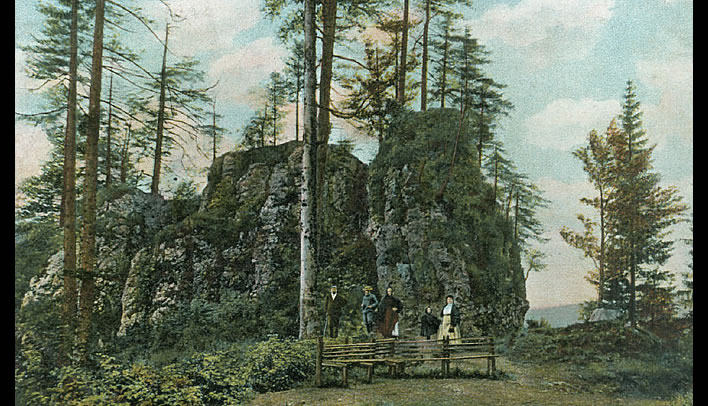
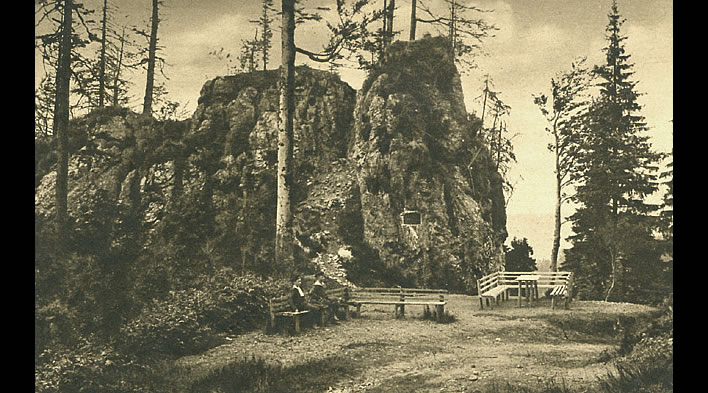
Two undated postcards showing the Hermannstein on the Kickelhahn. In 1913 the descendents of Ritter ('Knight') Hermann von Witzleben (1340-1393), who was known as 'Hermann Steyn' and gave his name to the rock, memorialised him with the plaque that can be seen in the lower image. Since this vandalism was not enough, a scaffolding viewing platform has recently been built on the top of the stone with a large set of metal stairs leading up to it. The stairs are closed in winter (health and safety) and at the time of writing the cave (behind the stone in this view) is closed (ditto). There are two other large plaques on either side of the entrance to the cave. Barbarism: where Goethe leads with his hammer and chisel, others follow. Images: Goethezeitportal.
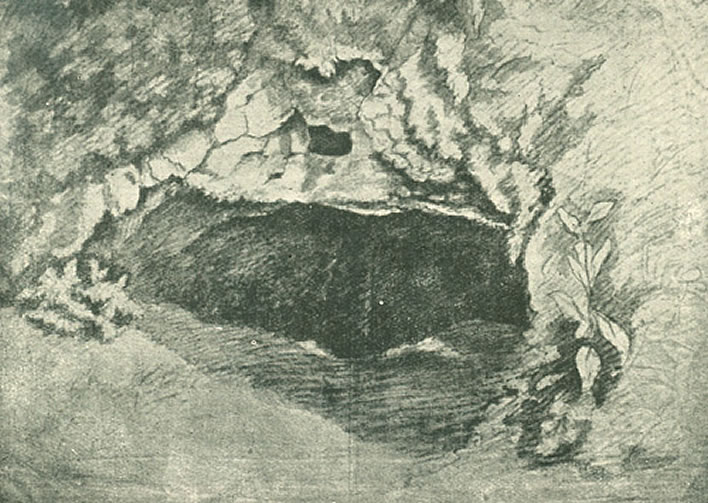
The entrance to the Hermannstein cave in a drawing done by Goethe on 8 April 1776. The entrance is about the height of an adult. Image: Goethezeitportal.
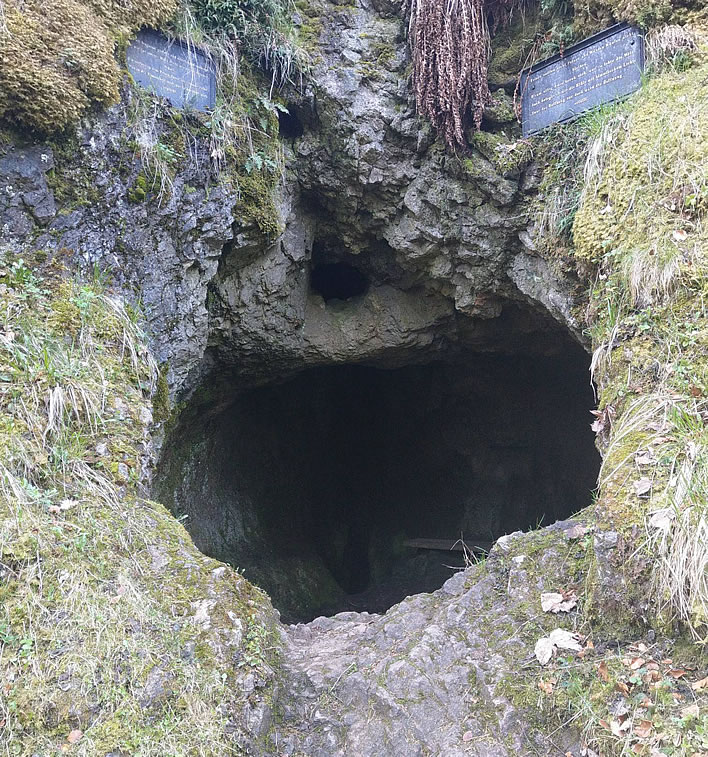
The Hermannstein cave in April 2018. It's difficult to see what Goethe saw in this place – perhaps he just didn't want to write it down. Image: Christoph.
The image of Wolfgang sniffing and kissing the dank rocks in the cave he and Charlotte had shared – we put in no more strongly – four long years before brings us nicely back to his geological interests and our speculative remarks over the interpretation of the fourth axis that we imagined for Wandrers Nachtlied II.
Goethe's relationship with rocks was almost mystical. At the time this poem was written he was exploring the geology of Thuringia as part of his service to his Duke. One of Goethe's greatest administrative projects at that time was to encourage the development of mining in and around Ilmenau. He himself had been crawling around mineshafts at the root of the earth.
At that time geology and the structure of the earth was one of his greatest preoccupations. Those who read his letters of this period will encounter again and again – even in his 'love letters' to Charlotte von Stein – signs of his rock fixation. A few days after his stay on the Kickelhahn he is informing his loved one that Von Gesteinen ist sehr viel gesammelt worden, 'A lot of rock samples have been collected' (14 September). On 27 December he writes to his Duke:
I am going to communicate all the essays about this to Trebra and respectfully request that in this way he traces the strata step by step from the summit of the Brocken, which consists of granite rock, down to the deepest tunnels of the Harz mines. If we come together and compare the names of the rock types and in this way see the various mountains with a single view we can claim a pretty piece of land for Natural History.
Wie ich denn alle Aufsätze hiervon an Trebra'n zu communiziren im Begriff stehe, mit der inständigen Bitte, daß er auf eben die Weise vom Gipfel des Brocken, der aus Granitfelsen besteht, bis in die tiefsten Schachten der Harzer Bergwerke, wie ich es gethan, die Schichten stufenweise verfolgen möge. Wenn wir nun also gegen einander zurücken, uns über die Namen der Gesteinarten vergleichen und so verschiedene Gebirge mit einerlei Augen sehen, können wir wohl ein hübsches Stück Land für die Naturgeschichte erobern.
If now we return to Goethe, our geologist-poet, observing the surrounding landscape from the summit of the Kickelhahn at sunset on 6 September, we realise that he does not look at landscapes in the way conventional poets do:
The sky is a completely clear and I am going off to enjoy the sunset. The view is great but simple.
The sun has gone down. This is the place where I drew the picture of the mist rising. Now it is so pure and quiet, and as uninteresting as a great beautiful soul when it is feeling its happiest.
Without the vapours rising from the mills the entire scene would be completely unmoving [= still].
Es ist ein ganz reiner Himmel und ich gehe des Sonnen Untergangs mich zu freuen. Die Aussicht ist gros aber einfach.
Die Sonne ist unter. Es ist eben die Gegend von der ich Ihnen die aufsteigenden Nebels zeichnete iezt ist sie so rein und ruhig, und so uninteressant als eine grose schöne Seele wenn sie sich am wohlsten befindet.
Wenn nicht noch hie und da einige Vapeurs von den Meulern aufstiegen wäre die ganze Scene unbeweglich.
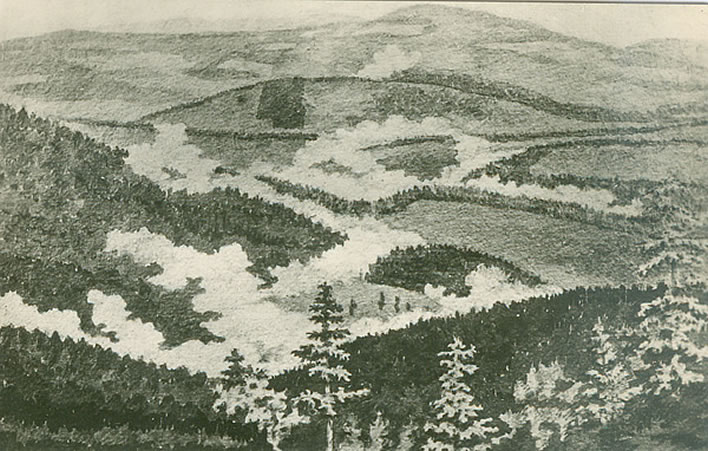
Goethe's drawing of the 'steaming' valleys around Ilmenau as seen from the south side of the Hermannstein. This was drawn on the occasion of an earlier visit to the Kickelhahn in 1776 Image: Goethezeitportal.
Graffiti
That evening of 6 September, Goethe wrote the poem we know as Wandrers Nachtlied II (without a title, though) on the wall of the dormitory on the upper floor of the hunting lodge, just on the left of a window that looks out over the scene at the centre of the poem.
If you take a run at this sentence and read it fast enough you may get safely on to the subsequent text. But if you are a grumbler with a hang to pedantry, this statement will stop you in your tracks. Why on earth did he do that? How did he do that? What was the exact text of this Ur-version? Answers: don't know, don't know, don't know. There is no contemporary source for this act at all. The first question – though it is rarely posed – is traditionally answered with the assertion that this was some kind of 'Kilroy was here' moment for Goethe. Well, perhaps… He had a number of these in his life.
It seems he had few inhibitions about leaving his mark on some piece of raw nature when it suited him – but Nature has time and patience on her side to lick her wounds and nearly all of these defilements have passed into oblivion like their author.
And when we consider that notebook, why did this poem apparently never find its way onto its pages? He certainly made sketches of the location – considerably more time-consuming – but never wrote down the poem that would make it world famous. Instead he is supposed to have scratched this poem onto the wall of the dormitory in pencil. There is, however, a pleasing ontological symmetry in writing the poem next to the view on which it is based.
If we accept that Goethe scribbled his poem in pencil on the wooden wall, we still have to suspend disbelief in what happened after that. This piece of poetic graffiti now disappears without trace from the Goethe record – letters and journals – for just over fifty years.
It resurfaces in 1831, on 27 August to be precise, the day before Goethe's eighty-second birthday, his last as it turned out, for he died seven months later on 22 March the following year.
On that day he visited Ilmenau and took a coach in the company of the mines inspector Johann Christian Mahr almost to the summit of the Kickelhahn (the wildernesses of Europe were starting to be opened up to tourism). Unfortunately, the publicly available account of that visit we only have at third hand:
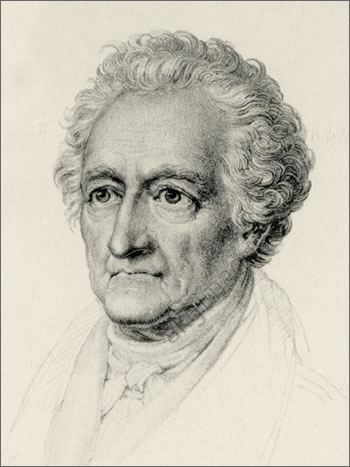
The last portrait of Goethe, done in Januar 1832, his death year. Carl August Schwerdgeburth (1784-1878). Image: Berlin, Sammlung Archiv für Kunst und Geschichte.
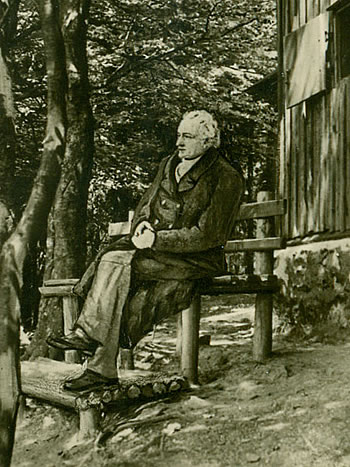
A fantasy image of the aged Goethe sitting near the hunting lodge on the Kickelhahn in 1831. Image: Goethezeitportal.
So then he strode over the ground overgrown with blueberry bushes to the forest refuge. He did not enter the lower room but went straight upstairs. On entering the upper room he said: 'In earlier times I wrote a small poem on the wall. I'd like to see that poem once more.' Mahr led him to the south-facing window. There on the lefthand wooden window frame, written in pencil, stood:
Über allen Gipfeln ist Ruh,
In allen Wipfeln spürest du
Kaum einen Hauch!
Die Vögel schweigen im Walde.
Warte nur, balde
Ruhest du auch.Goethe read the poem and seemed to be deeply moved. Very slowly he took his white handkerchief from his dark-brown, long frock coat, dried his tears and repeated slowly and wistfully: 'Yes, just wait, soon you too will be at peace.' Then he was silent for a moment, glanced once more through the south window at the beautiful view of the woods towards Stützerbach and then said, turning to Mahr, 'Now we want to go!'
So schritt er über den mit Heidelbeersträuchern bewachsenen Platz zum Forstschutz-Häuschen. Die untere Stube besah er nicht, sondern ging gleich nach oben. Beim Eintritt in das obere Zimmer sagte er: 'Ich habe in früherer Zeit einen kleinen Vers an die Wand geschrieben. Wohl möchte ich diesen Vers nochmals sehen.' Mahr führte ihn an das nach Süden zu gehende Fenster; da stand an der linken hölzernen Fensterbekleidung mit Bleistift:
Über allen Gipfeln ist Ruh,
In allen Wipfeln spürest du
Kaum einen Hauch!
Die Vögel schweigen im Walde.
Warte nur, balde
Ruhest du auch.
Goethe las die Verse und schien tief bewegt. Ganz langsam zog er sein weißes Taschentuch aus seinem dunkelbraunen, langen Tuchrock, trocknete sich die Tränen und wiederholte langsam und wehmütig: 'Ja, warte nur, balde ruhest du auch.' Dann schwieg er eine kleine Weile, überflog mit den Augen nochmals durch das südliche Fenster die schöne Waldaussicht nach Stützerbach zu und sagte zu Mahr gewandt: 'Nun wollen wir gehen!'
We cynics, distrustful as ever, hold our noses at such third-hand reports, for, dipping into other sources, we hear of Goethe asserting that he had written the poem on 7 September 1783; we read that Goethe (or someone) wrote Am 2. September 1783 above the text on the wall; we read in other places that Goethe traced over the text and added the line Renov. d. 28. August 1831, 'Renovated on 28 August 1831'.
The question of whether, when he traced over the text, he made any changes to it to bring it up to the standard he had established in its publication in 1815 no one can answer.
Furthermore, whichever of the various dates for the creation of the poem we hear about, we are astonished at the precision of Goethe's memory after 50 years – since he doesn't seem to have dated the original, from where, 50 years on, does he conjure the date, month and year of his creation?
Goethe certainly visited the Kickelhahn on that occasion in 1831, for he wrote to his longtime friend, the composer Carl Friedrich Zelter (1758-1832) about the visit on 4 September 1831:
… on the wall of a wooden shed on the highest summit of the Tannenwälder I recognised the inscription from 7 September 1783 of the song which you took on the wings of music so charmingly soothingly out into the wide world.
'Über allen Gipfeln ist Ruh etc.'
After so many years one could see: the durable, the disappeared. The successful came up and cheered us, the unsuccessful was forgotten and its pain overcome.
… auf einem einsamen Bretterhäuschen des höchsten Gipfels der Tannenwälder recognoscirte ich die Inschrift vom 7. September 1783 des Liedes das du auf den Fittigen der Musik so lieblich beruhigend in alle Welt getragen hast:
'Über allen Gipfeln ist Ruh pp.'
Nach so vielen Jahren war denn zu übersehen: das Dauernde, das Verschwundene. Das Gelungene trat vor und erheiterte, das Mißlungene war vergessen und verschmerzt.
Once more we are astonished at the precision with which he recalls the date of the creation of the inscription. But with that 1831 letter to Zelter we come to the end of Goethe's participation in his own piece of graffiti. German legend building can now take over.
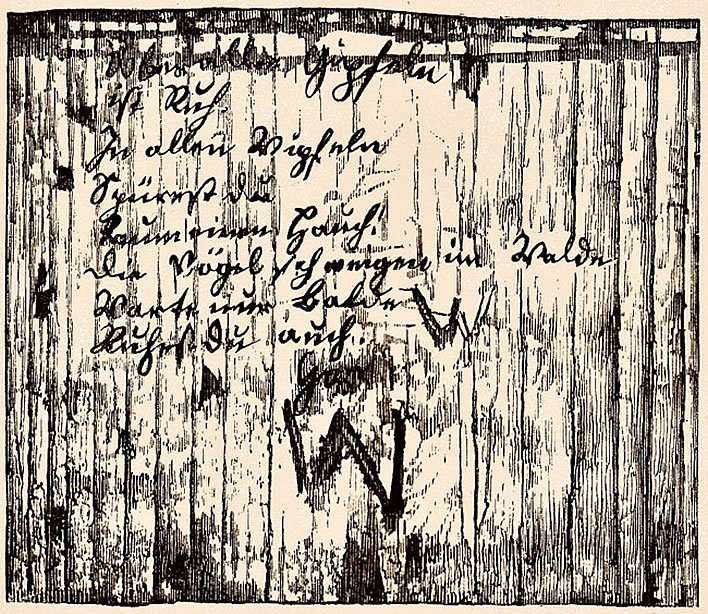
A reproduction of Goethe's poem as it appeared on the wall of the hunting lodge on the Kickelhahn. The reproduction appeared in 1872 in the Gartenlaube, the 'Garden Arbour' a popular weekly 'family paper', in an article on the Kickelhahn lodge and Goethe's poem (Issue No. 40). We are told that the image is a reproduction of a photograph that was taken 'a few years ago', before the lodge burned down in 1870, cremating Goethe's inscription in the process. The article in the Gartenlaube is full of wild assertions on the subject, but once the lodge had burned down, nothing more stood in the way of some serious legend building. Image: Goethezeitportal.
The Gartenlaube titled the illustration Goethes Handschrift im Kickelhahn-Häuschen, 'Goethe's handwriting in the Kickelhahn lodge'. The image presents us with a number of puzzles. Firstly this text was certainly not written or overwritten in pencil. The pronounced flow of thick and thin lines suggest that it was written with pen, certainly not a brush. How someone wrote this text with a pen on a vertical wooden surface is a mystery. It looks as though the magazine wanted to make Goethe's text more legible for their readers, so they 'improved' the image by overwriting the text, apparently with an ink pen.
This becomes obvious when we compare the Gartenlaube image with some other images of the now conserved photograph:
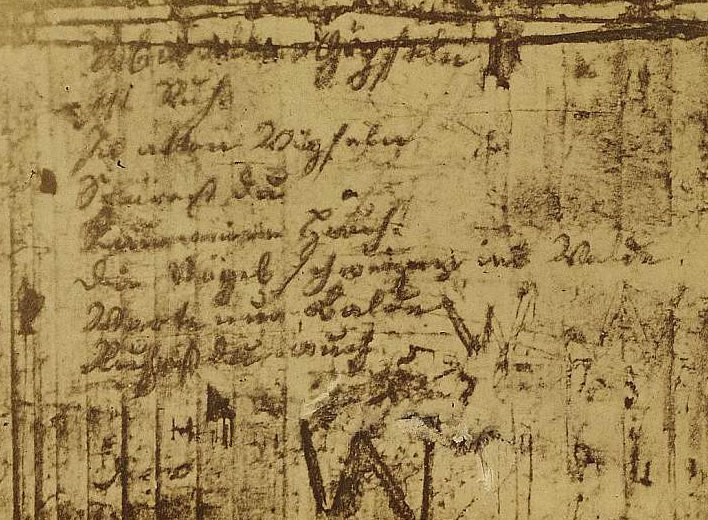
The reproduction of the photograph shown in the GoetheStadtMuseum, Ilmenau. For three Euros the museum will let you look at their collection of other people's work, this image included. Image: GoetheStadtMuseum Ilmenau.
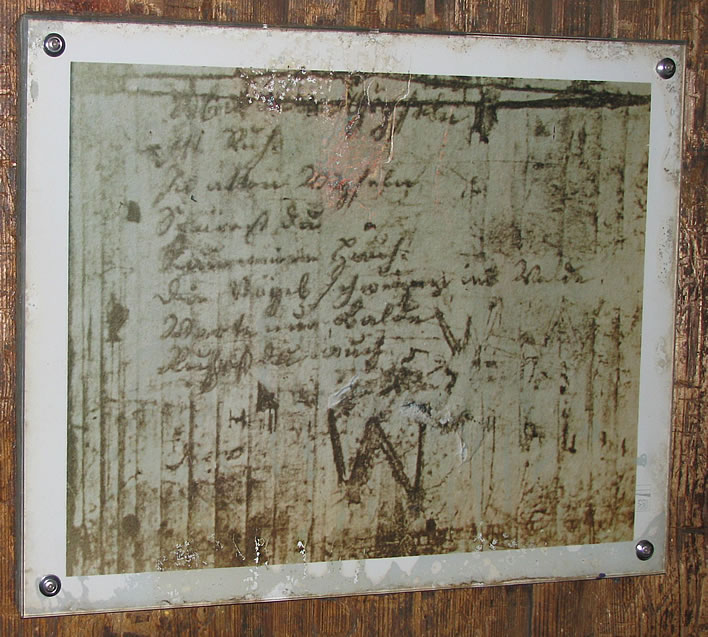
The copy of the inscription mounted under glass in the rebuilt lodge on the Kickelhahn. Image: Leonóra Mörk.
An inspection of the image raises more questions than it answers:
- From the anecdotes of Goethe's 'recognition' of the graffiti text we would expect to find a creation and a renovation date. Neither of them are visible in this image.
- It is difficult to judge, but this hardly seems to be written on a Fensterbekleidung, 'window frame'.
- On the Gartenlaube version, the magisterial signature 'Göthe' strikes us as odd – and its position as even odder. It seems likely that this is another fantasy improvement by the magazine.
- There are a number of differences between this text and all the other variants that we have, but in the general chaos of texts this hardly means anything.
Over the next ninety years successive visitors to the hunting lodge performed their secret ministry on the inscription in some way or other – defaced it, wrote over it, generally messed around with it until finally the gods took pity on humankind and in 1870 burnt the lodge down and Goethe's now almost unreadable poem with it.
Fortunately, this tale makes no difference to anything. It has made the tourist organizations of the region very happy down the years, but in terms of the transmission of Goethe's text it has no importance at all.
Indeed, if you make a pilgrimage to the Kickelhahn to trace the footsteps of the great man there is nothing more of him there. Nothing. What you will find is just the arty-farty fakery of modern museum tourism. The genius loci fled this place two centuries ago for somewhere more rewarding and left it to the humans to do their worst. Which is what they have done.
The upper floor in the fake lodge contains a large glass wall with an arty inscription of Wandrers Nachtlied II and translations of it into about 20 languages around it – the irony of producing such a monumental installation for a poem scratched in pencil on a wooden wall is clearly lost on those in charge of the fakery, as is the equal irony of placing all that translation around the essentially untranslatable German original. The English translation is a 1998 effort from John Whaley (1927-2005), quite pleasant, but with only the most tenuous links to the original:
Wanderer's Evening Song
Over all of the hills
Peace comes anew,
The woodland stills
All through;
The birds make no sound on the bough.
Wait a while,
Soon now
Peace comes to you.
John Whaley, 21 August 1999. A flyer produced by the Stadtverwaltung Ilmenau containing all the available translations can be downloaded here (PDF).
Text history and versions
If we now shake off all the irrelevancies of the scribbling on walls we can concentrate on the publishing history of the work.
Goethe's text for Wandrers Nachtlied II first appeared in Cotta's Complete Works in 1815. For some reason Goethe did not include it in the Göschen Complete Works of 1786-90. Perhaps he had simply forgotten about it or overlooked it, perhaps the text was still scribbled on the wall of the hunting lodge in the Kickelhahn. Who knows why? True to its theme of peace and silence, the poem itself seems to have gone to sleep for nearly 35 years before it finally made it into print in 1815.
If only it were so easy. For during the time we imagine the poem snoozing peacefully on the Kickelhahn wall or on a scrap of paper at the bottom of a drawer in Goethe's house or even just hanging around in Goethe's memory, strange variants of it are being published. Precisely where all these variants came from, no one knows. We can be fairly sure – fairly sure – that none of these were copied from the scratchings on the wall – although admittedly it would help if we knew something reliable about the text on the wall.
One early variant comes from Johann Gottfried Herder, who, as we have seen in respect of Goethe's Heidenröslein and Der Fischer, was orbiting around Goethe in his pursuit of Volkslieder, 'folk poetry'. Herder reproduced the poem, but with some substantial changes from the text we know now.
A variant appeared in a British publication The Monthly Magazine in 1801:
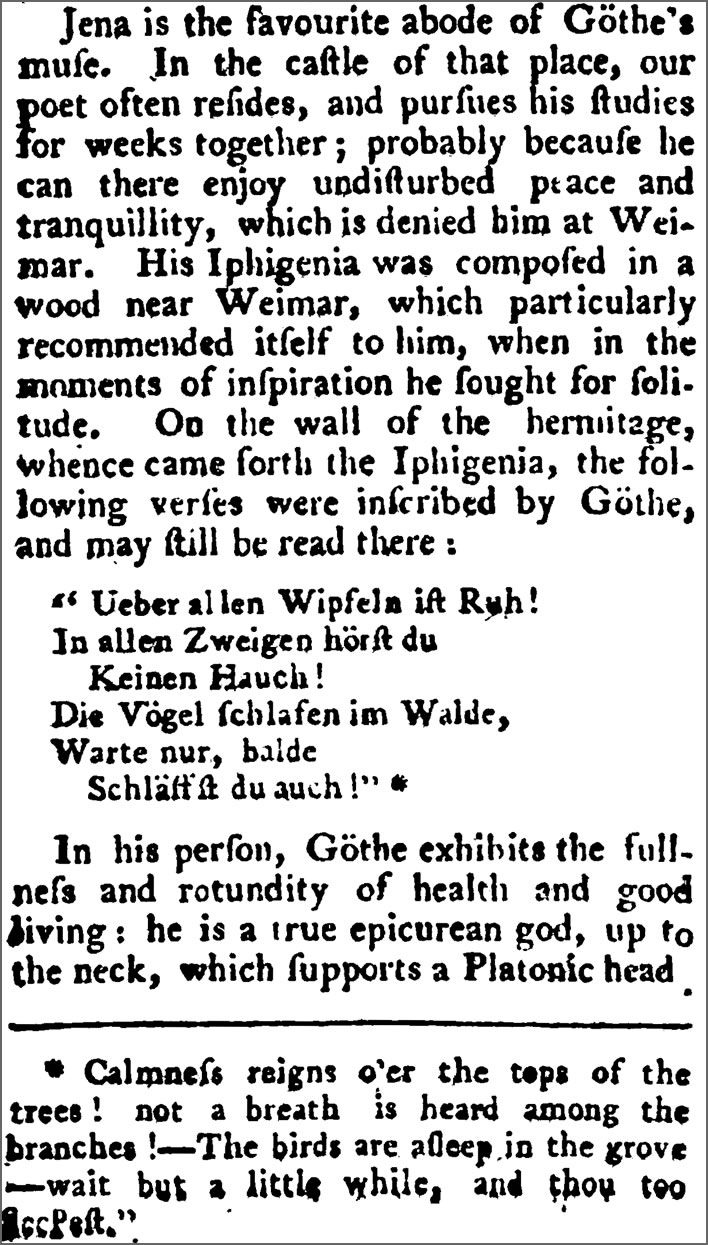
Anonymous article in The Monthly Magazine, London, 1 February 1801.
A further variant of the poem was published in Der Freimüthige in Berlin in 1803. Once again, no one knows where that text came from, although the article referred to the piece in the English publication.
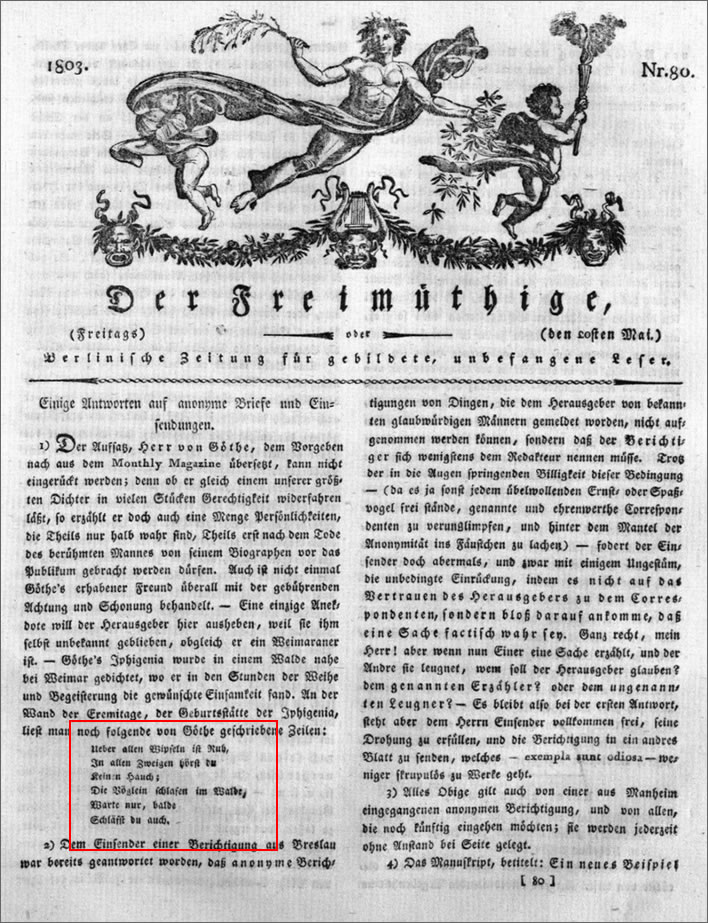
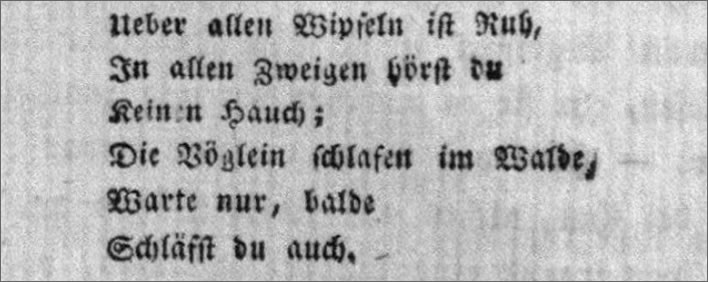
From Der Freimüthige, oder Berlinische Zeitung für gebildete, unbefangene Leser, 20 May 1803, No. 80, p. 317. The magazine was edited by August von Kotzebue.
Even more mysterious, in 2001 a manuscript paraphrase of Goethe's poem done by Heinrich von Kleist (1777-1811) turned up at auction. Scholarly heads were scratched, bar fights broke out in the Mensa – where did Kleist get his text from? Was it a bad copy from memory, a paraphrase, a parody or an attempt at improvement? It seems reasonable to assume that Kleist read Goethe's poem in 1803 in Der Freimüthige, but why the changes? and when did he write it? Kleist's handwriting in the document suggests that he wrote it at the earliest around 1808.
We have no answers for any of these questions.
Summing up: In the course of 35 years we have a poem (text possibly known) scratched on the wall of a hut; we have a number of 'wild' publications with varying texts; we have a heavily modified version in a Kleist manuscript; the poem is missing altogether from the 1786 Collected Works and finally appears in all its perfection in 1815. That was the troubled birth of what became one of the most famous poems in German.
Schubert's setting
Your author has no musical competence whatsoever. In most matters of musical taste concerning Schubert's songs he defers to Dietrich Fischer-Dieskau. There must be many other excellent performers of Schubert's songs, but Fischer-Dieskau shows himself to be an extremely perceptive reader of German poetry. Of Wandrers Nachtlied II he wrote:
Three dozen songs came into being in 1823! Among them Goethe's Wanderers Nachtlied [II], which makes once again clear how unimportant the length or the brevity of a piece of music is for its expressive power. The musical substance alone is decisive. Alfred Einstein correctly designated this wanderer's night song as 'the most beautiful of the hundreds of settings of this poem'.
Drei Dutzend Gesänge waren 1823 entstanden! Darunter Goethes WANDERERS NACHTLIED, das wieder einmal deutlich macht, wie unwichtig die Länge oder Kürze eines Musikstücks für seine Aussagekraft ist. Die musikalische Substanz allein ist entscheidend. Dieses Nachtlied des Wanderers wird von Alfred Einstein zu Recht als die »schönste der Hunderte von Vertonungen dieses Gedichts« bezeichnet.
[Fischer-Dieskau, Dietrich. Auf den Spuren der Schubert-Lieder; Werden, Wesen, Wirkung, Wiesbaden: F. A. Brockhaus, 1971. p. 214.] All translations ©FoS.
Fischer-Dieskau is quite right to put an exclamation mark at the end of his first sentence. Those who know what a medical vale of tears the year 1823 was for Schubert would be inclined to put three of them as signs of astonished respect for not only the quantity but also the quality of his output.
The way that the representation of the scene and the meanings of the feelings align here has been convincingly and penetratingly analysed by Georgiades in his book about Schubert. This publication of the scholar from Munich can only be warmly recommended for the clarification of the relationship of word and sound in Schubert.* It only remains here to say that the introductory bars signify the death rhythm, in this case the longing for peace.
Wie hier die Darstellung der Szene und die Bedeutung der Empfindungen übereinstimmen, analysiert Georgiades in seinem Schubertbuch überzeugend und eindringlich. Überhaupt sei diese Veröffentlichung des Münchener Gelehrten zur Erhellung des Verhältnisses von Wort und Ton bei Schubert wärmstens empfohlen.* Hier bleibt nur zu sagen, daß die Einleitungstakte auf den Todesrhythmus, in diesem Falle die Sehnsucht nach Ruhe, hindeuten. [Ibid 215]
Georgiades work is indeed a remarkably perceptive analysis. It goes far beyond the scope of the present treatment but should be required reading for those intending to perform this song. [*Georgiades, Thrasybulos G. Schubert: Musik und Lyrik, Volume 1, Vandenhoeck and Ruprecht, 1979, pp. 17-39.]
It is noteworthy that composers have attempted to approach the Nachtlied in the most diverse ways: the settings appear as songs for one voice, as duet, trio, solo quartet, choral quartet or male voice choir. Goethe wrote the eight short lines of poetry on 6 September 1780 on the wall of a hut on the Kickelhahn in Thuringia. Thirty-three years later he renewed the inscription and as an old man he read it once more with tears in his eyes.
Bemerkenswert, daß sich die Komponisten dem Nachtlied auf den verschiedensten formalen Wegen zu nähern versuchten: die Vertonungen präsentieren sich als einstimmiges Lied, als Duett, Terzett, Soloquartett, Chorquartett oder Männerchor. Goethe schrieb die acht kurzen Gedichtzeilen am 6. September 1780 auf die Wand einer Hütte auf dem Kickelhahn in Thüringen. 33 Jahre später erneuerte er die Inschrift, und als Greis las er sie dort unter Tränen wieder. [Ibid 215]
Despite his normally sound scholarship, Fischer-Dieskau is here tripped up by a century of legend building. There is no record of Goethe having visited and renewed his pencil inscription in the hut on the Kickelhahn 33 years after he wrote it, that is, in 1813. As we know, according to Mines Inspector Mahr, Goethe saw and renewed the inscription (with tears in his eyes) in 1831, giving no hint that he had encountered it again between then and its creation in 1780. Anything is possible in this world of fairy stories, though.
Schubert's epigram has no equal in its concentration over 14 bars. Friedländer deleted the double beat on 'balde' as a later 'embellishment', which Mandyczewsky in his complete edition retained.
Schuberts Epigramm hat in seiner Konzentration auf 14 Takte nicht seinesgleichen. Friedländer streicht den Doppelschlag auf »balde« als später zugefügtes »embellissement« fort, den Mandyczewsky in seiner Gesamtausgabe noch abdruckt. [Ibid 215]
Performances
As a reminder, the text with Goethe's enjambement and caesura marked up:
Ueber allen Gipfeln ist Ruh',
in allen Wipfeln spürest Du kaum einen Hauch;
die Vögelein schweigen im Walde.
Warte nur!
Balde ruhest du auch.
An undated performance of Wandrers Nachtlied II by the baritone Karl Schmitt-Walter (1900-1985) accompanied by the pianist Michael Raucheisen (1889-1984).
A 1969 performance of Wandrers Nachtlied II by the baritone Dietrich Fischer-Dieskau (1925-2012) accompanied by pianist Gerald Moore (1899-1987), demonstrating in particular Fischer-Dieskau's scrupulous adherence to Goethe's and Schubert's enjambements. The tempo is appreciably slower than that of Schmitt-Walter's version.
A fine rendering by the incomparable bass Hans Hotter and pianist Gerald Moore. Recorded in London in October 1949. Hotter pays due respect to the enjambements in the long legato line in allen Wipfeln spürest Du kaum einen Hauch, but unfortunately has to surface for air after kaum – although he handles the situation well.
An uptempo version by Karl Erb and an unknown pianist in Berlin, February 1914. Just the thing to take with you into the trenches to cheer everyone up.
Conclusion
Goethe's own offhand treatment of Wandrers Nachtlied II tells us that he thought of the poem as being nothing special, one of those poems that busy geniuses knock off without a second thought and then move on.
Even when he finally got round to recognising its existence by including it in his Complete Works of 1815, the poem seemed to mean nothing special for him: he placed it after an earlier poem he titled Wandrers Nachtlied [I].
The new poem was given the rather dismissive, anonymising title Ein gleiches, 'Another of the same'. This careless title, in its unusable meaninglessness, has been an annoyance to everyone since then. The particular annoyance came from the fact that the preceding Wandrers Nachtlied, a poem also of eight lines written 'on the slopes of the Ettersberg' on 12 February 1776, is routine versifying that is a long way beneath the level of Ein gleiches. Not bad – Goethe never wrote bad poetry – but mundane in every respect: metrics, diction, meaning etc.
By coupling the two poems together, he reveals that Ein gleiches was also a poem about weariness and the longing for peace, rest and sleep:
| Der du von dem Himmel bist, Alles Leid und Schmerzen stillest, Den, der doppelt elend ist, Doppelt mit Erquickung füllest, Ach, ich bin des Treibens müde! Was soll all der Schmerz und Lust? Süßer Friede, Komm, ach komm in meine Brust! |
You who are from Heaven, who soothes all sorrow and pain and who fills the doubly suffering with double refreshment, Oh, I am tired of this bustle! Why all this pain and joy? Come, sweet Peace, oh, come into my breast! |
Those readers who have dutifully ploughed through our encomium to the poetic qualities of that seeming afterthought, Ein gleiches, will immediately realise how Goethe goes wrong when he leaves the solid empirical foundations of that poem.
In Wandrers Nachtlied [I] we have a poem of feelings and no facts. It talks about emotion, but lacks the 'objective correlatives' (©T.S. Eliot) to call up those emotions in the reader. In comparison with Wandrers Nachtlied [I], we would be quite justified in calling Ein gleiches an epochal piece of poetry.
Goethe's failure to appreciate the outstanding quality of his own poem must constitute one of the oddest events in literary history. It seems – 'it seems', our favourite phrase these days – that Goethe only read the poem in the same way that everyone else reads the poem when he recognised his own memorial that he had scratched on the wall of the hut on the Kickelhahn fifty years previously.
Schubert read it this way, too – as Fischer-Dieskau hinted: 'the introductory bars signify the death rhythm'. In early 1823, that annus horribilis of disease, loneliness (so many friends were absent), of lack of money and lack of recognition, when he set Wandrers Nachtlied II to music, he must have sensed the Damocles sword hanging over him. Warte nur! balde Ruhest du auch, 'Just wait, soon you will be at peace, too.'
Schubert's setting, this magnificent thing, remained unseen for four years. In 1827 it was printed in a music supplement in the Wiener Zeitschrift für Kunst, Literatur, Theater und Mode (Saturday 23 June) and finally, in 1828, popped into an album with three other songs (one good, two abysmal) that was dedicated to Charlotte, Princess Kinsky. It did get published before his death – just. He might have been better just scratching it in pencil on a coffee house wall, thus leaving something behind for the tourists.
His setting of Goethe's poem is impeccable. But then we are used to that in Schubert. In the presence of masters such as Goethe or Rückert, and particularly in their presence on their best days, he rises to sublime heights. The musical genius stands on the shoulders of the literary genius and leaves a great monument to such collaborations.
Sources
For those who read German, the most thorough discussion of Wandrers Nachtlied II is contained in Segebrecht, Wulf. Goethes Gedicht über allen Gipfeln ist Ruh und seine Folgen. Texte, Materialien, Kommentar, Hanser (258), München, 1978, pp. 215. Although now more than forty years old, it remains the starting point for all later commentary.
0 Comments UTC Loaded:
Input rules for comments: No HTML, no images. Comments can be nested to a depth of eight. Surround a long quotation with curly braces: {blockquote}. Well-formed URLs will be rendered as links automatically. Do not click on links unless you are confident that they are safe. You have been warned!